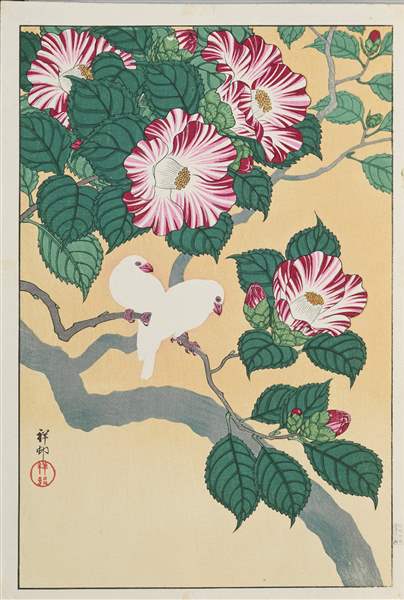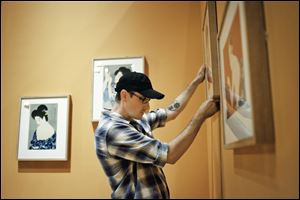
Exhibit of lush Japanese prints opens this week at Toledo Museum of Art
9/28/2013

Art Handler Timothy Gaewsky hangs a frame on a wall in preparation for the exhibit "Fresh Impressions: Early Modern Japanese Prints" at the Toledo Museum of Art. The exhibit is set to open on Oct. 4.
Kendall Brown can’t wait to feast his eyes on what he calls the “mother lode.”
Katherine Martin tosses out words like “legendary,” “amazing,” and “exciting.”
For her part, Carolyn Putney wants to reclaim a bit of the Toledo Museum of Art’s history and make people like Brown and Martin — experts in Japanese woodblock print art called shin hanga — and the general public swoon over the beauty and grace of Fresh Impressions: Early Modern Japanese Prints when the exhibit opens this week.
“It’s a huge deal,” said Brown, a scholar and professor of Asian art history at California State University Long Beach.
“Shin hanga print fans from Europe, around North America, and Japan are just waiting breathlessly for this exhibition to see so many prints. I mean most museums will put out 70, 90, maybe 120, but to have... almost 350 will have a kind of scope and critical mass that we’ve never seen in North America ever, even bigger than the colossal show of 1930.”
The excitement centers around a collection that has mostly been kept under wraps for decades, a practical decision by the Toledo museum to preserve the historic pieces that coincidentally served to create a buzz among scholars and collectors eager to see these long out of circulation works.
Populist art form
Shin hanga (new prints) is a contemporary art movement that began in Japan in 1915. It involved painstakingly carving wood blocks that were saturated with paint and used to produce watercolor prints of actors, beautiful women, the natural world, and landscapes. It was a collaborative process that involved an artist, a carver, and a printer.
The paintings were generally not abstract and were considered a populist form of art that sold for $3 to $5 and were hung on the walls of ordinary people’s homes, Putney said. A variety of artists at the time had revived the old print-making process.
“At the time they were an inexpensive way of decorating your house. These were contemporary Japanese artists who had revived this traditional form of art,” she said.
The 10 artists in the exhibition are Hashiguchi Goyo (1880-1921), Ito Shinsui (1898-1972), Kawase Hasui (1883-1957), Miki Suizan (1887-1957), Natori Shunsen (1886-1960), Oda Kazuma (1882-1956), Ohara Shoson, also known as Ohara Koson, (1877-1945), Yamamura Toyonari, also known as Yamamura Koka, (1885-1943), Hiroshi Yoshida (1876-1950), and Yoshikawa Kanpo (1894-1979).
Toledo connection
Shin hanga gained exposure in the United States during the 1920s when Yoshida brought a traveling exhibit to the country to raise money for victims of the 1923 earthquake. His work caught the attention of a pair of ambitious Toledo museum leaders, J. Arthur MacLean and Dorothy Blair.
MacLean had accepted the job in 1926 as curator of Oriental Art at TMA and his associate Blair, who had spent several years living in Japan, became the museum’s assistant curator.
Both were aggressive in establishing the museum’s reputation in Asian art circles . In 1930 they mounted what is still considered the pre-eminent exhibit of shin hanga in the western hemisphere and it traveled to several other museums.
The show of 343 works and the catalog that accompanied it are now legendary. The catalog became the Bible of the art form and Putney said that over the years it has been copied so many times that it is falling apart.
“There is still a demand for this catalog and the reason is that it is the only documentation of a series of exhibitions that went around the United States at the time,” she said.
A sister exhibit in 1936 didn’t garner quite as much attention, but local business leader H.D. Bennett of Toledo Scale purchased all of the original prints that were displayed in 1930 and they became the property of the museum.
“The show they had eventually became their collection so they were sitting on a treasure trove of works of their type, arguably one of the most important collections of shin hanga outside of Japan. I think it’s 343 prints they’re putting up? Amazing. It’s going to be really exciting,” said Martin, director of the Scholten Japanese Art, a New York gallery.
Under wraps
History conspired against the shin hanga movement in a number of ways as popular tastes veered toward abstract works and more modern techniques and World War II occurred, which meant “no one really wanted to see Japanese anything for quite some time. They would come out occasionally, but not as a whole group,” Putney said.
But Japanese art historians and collectors such as Martin and Brown were very much aware of Toledo’s collection and the catalog, making pilgrimages here to look at the works with special permission from curators. Occasionally some of prints were brought out, including in the Strong Women, Beautiful Men: Japanese Portrait Prints from the Toledo Museum of Art exhibit in 2005.
Brown has traveled here to see the prints and he has long been amazed at their vibrant colors and pristine condition. He also wrote an essay for the sumptuous new catalog that features photos of all the works

“The condition is unparalleled. Most Japanese prints have been shown a long time on people’s walls and then given to museums and they fade relatively easily and quickly. Most of these were never shown or rarely shown and the condition is pretty spectacular,” he said.
Fresh Impressions
The museum was able to borrow the seven prints that it no longer owns and the show that opens Friday and runs until Jan. 1 also will include kobuki costumes, samurai swords, kimonos, and other artifacts such as miniature sculptures called netsuke. Basically it’s a repeat of the 1930 show, only presented in a far less spartan fashion and with a number of additional features.
Putney has been with the Toledo museum since 1978 and she has been dying to put on this exhibition for years. She lauded director Brian Kennedy for his role in breaking it out.
“It’s been a dream of mine for a long time and I was just thrilled that Brian gave me the opportunity because these were seminal shows in 1930 and 1936 featuring the works of these contemporary Japanese artists. To me, I think it’s a really exciting opportunity to show an entire collection that people don’t get to see very often,” she said.
She believes the general public will be surprised by the vibrancy of the works.
“Many of the Japanese prints that you see are just a pale reflection of what they were originally. So when you see these, people can’t even believe the color in them. They are pristine,” she said.
And when it’s over? The prints will be bundled up and put back in storage to preserve their quality for future generations.
Fresh Impressions: Early Modern Japanese Prints opens to the public Friday and runs until Jan. 1. It is free and will be in the Toledo Museum of Art’s Canaday Gallery. The museum is open Tuesdays and Wednesdays from 10 a.m. to 4 p.m.; Thursdays and Fridays from 10 a.m. to 9 p.m.; Saturdays from 10 a.m. to 5 p.m.; and Sundays from noon to 5 p.m. It is closed Monday and major holidays. Information: toledomuseum.org.
Contact Rod Lockwood at: rlockwood@theblade.com or 419-724-6159.